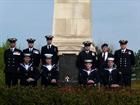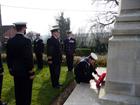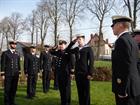Culdrose sailors visit WW1 battlefields
Personnel from Royal Naval Air Station Culdrose have paid homage to sailor-soldiers who fought on the Western Front a century ago. The sailors of 829 Naval Air Squadron (03 Flight), who usually fly and maintain a Merlin helicopter aboard today’s frigates, are touring Great War battlefields, in particular those where the Royal Naval Division fought.
Nearly a century later, sailors from 829 Naval Air Squadron are spending a week visiting the battlefields of northern France to learn of the sacrifices made by Allied troops almost 100 years ago.
The personnel normally fly and maintain a Merlin helicopter which joins Royal Navy frigates on deployments. But with the centenary of the Great War impending – accompanied by international commemorations – the sailors from RNAS Culdrose inCornwallwere keen to learn more. In particular, they’ve been following the footsteps of the Royal Naval Division, formed upon the outbreak of war from surplus sailors.
After inauspicious beginnings atAntwerp, the sailors-turned-soldiers fought with distinction in Gallipoli before being transferred to the Western Front in 1916, where they spent the remainder of the war. Among the sites visited by the 829 squadron sailors was thevillageofGavrelle, nearArras, captured by the Naval Division in the spring of 1917 for the cost of 192 lives and Vimy Ridge, famously seized by Canadian troops.
Guided by Culdrose’s health and safety advisor – and passionate Royal Naval Division historian – Aidan ‘Chippy’ Wood, the sailors moved south to the Somme: Flers, scene of the first tank battle, and Delville Wood, where South African soldiers suffered bloodily in the summer of 1916, and the Ancre valley, where the RND was committed in the final days of the Somme offensive.
The division lost an average of three officers and 53 men every day in November 1916 – nearly 4,000 dead and wounded by the month’s end, a fact which really hit home as the 829 squadron personnel walked the battlefield. The division stormed German positions at Beaucourt sur l’Ancre, where today an imposing obelisk stands in memory of the sailors’ deeds.
Fittingly, the Culdrose sailors held a short service of remembrance before laying a wreath at the foot of the monument; the memorial was paid for by Daily Mail owner Lord Rothermere, whose son Vere was killed on theSomme.
“It was a very meaningful and sobering day,” said Lt Cdr Simon Stevenson, who led the service. “Our small ceremony was very befitting for the exploits of these ‘land sailors’ who retook the village.”
Chief Petty Officer Gus Cowley added: “It was an experience I will never forget – to be fortunate enough to show our respect to fallen comrades and to lay a wreath at a relatively-unknown monument was an extremely proud moment for myself and fellow Flight members.”
At every step of their tour of the Western Front, the Culdrose sailors have been struck by the sheer scale of the sacrifice 100 years ago. “The human toll was on an almost industrial scale for the gains of a few yards. It’s been very humbling,” said Lt Cdr Stevenson.
His sentiments were echoed by WO2 Stuart Nanson, the flight’s senior engineer. “The sheer number of deaths in this small area was more than could ever have been expected.?Reading the personalised messages on gravestones from families of the soldiers was a very emotional and humbling experience.”
In all, some 50,000 men served with the Royal Naval Division during the war. One man in every five was killed. Despite such losses, the sailor-soldiers – who were true to their naval roots, keeping naval ranks, insignia and language – were regarded as some of the elite troops in the British Army by the war’s end.



